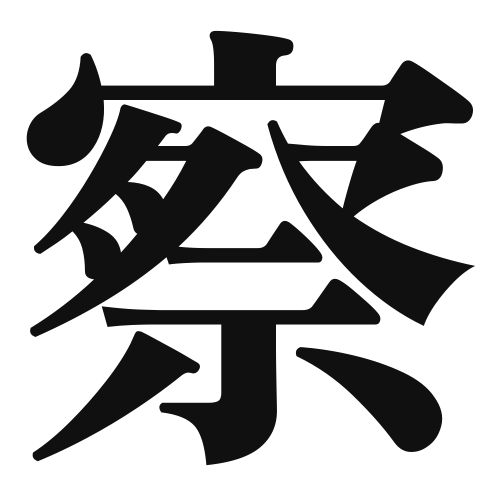1. Overview of Meaning
The kanji “察” (satsu) means to perceive, to guess, or to infer. It conveys the idea of understanding something without explicit communication, often through observation or intuition.
2. Formation and Radical
Formation of the Kanji: The kanji “察” is a compound character, which means it is formed by combining different elements. It is classified as a phonetic-ideographic character (形声文字), where the left part (the radical) gives a hint about the meaning, and the right part suggests the pronunciation.
Radical: The radical for “察” is “見” (mi), which means “to see.” This radical relates to the idea of observation, which is central to the meaning of the kanji.
3. Examples of Usage
Common Words and Phrases: Some frequently used words that include “察” are:
- 察知 (sacchi) – to perceive or detect
- 察する (sassuru) – to guess or infer
Example Sentences in Daily Conversation:
- 彼は私の気持ちを察してくれた。
(Kare wa watashi no kimochi o sasshite kureta.)
– He understood my feelings. - 状況を察するのは大切だ。
(Joukyou o sassuru no wa taisetsu da.)
– It is important to perceive the situation.
4. Synonyms and Antonyms
Similar Kanji with Related Meanings: A similar kanji is “理解” (rikai), which means “to understand.” The difference lies in that “察” emphasizes perception or inference, while “理解” focuses on comprehension.
Antonyms: An antonym for “察” could be “無視” (mushi), which means “to ignore.” This represents the opposite action of perceiving or understanding something.
5. Cultural and Historical Background
Connection to Japanese Culture: The concept of “察” is significant in Japanese culture, where non-verbal communication and intuition play a crucial role in social interactions. Understanding unspoken feelings is often valued.
Proverbs and Idioms: One relevant proverb is “察することは大切” (Sassuru koto wa taisetsu), which translates to “It is important to perceive.” This highlights the cultural emphasis on understanding others’ feelings and situations without direct communication.
